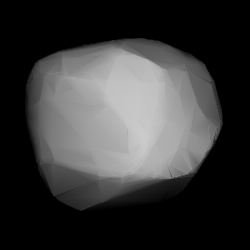 3D convex shape model of 159 Aemilia | |
| Discovery | |
|---|---|
| Discovered by | P. P. Henry |
| Discovery date | 26 January 1876 |
| Designations | |
| (159) Aemilia | |
| Pronunciation | /ɪˈmɪliə/[1] |
Named after | Via Aemilia |
| A876 BA; 1959 EG1 | |
| Main belt (Hygiea family) | |
| Adjectives | Aemilian /ɪˈmɪliən/[2] |
| Orbital characteristics[3] | |
| Epoch 31 July 2016 (JD 2457600.5) | |
| Uncertainty parameter 0 | |
| Observation arc | 112.24 yr (40996 d) |
| Aphelion | 3.4377 AU (514.27 Gm) |
| Perihelion | 2.76896 AU (414.231 Gm) |
| 3.1033 AU (464.25 Gm) | |
| Eccentricity | 0.10775 |
| 5.47 yr (1996.8 d) | |
Average orbital speed | 16.86 km/s |
| 214.036° | |
| 0° 10m 49.008s / day | |
| Inclination | 6.1308° |
| 134.132° | |
| 333.387° | |
| Earth MOID | 1.78581 AU (267.153 Gm) |
| Jupiter MOID | 1.67782 AU (250.998 Gm) |
| TJupiter | 3.203 |
| Physical characteristics | |
| Dimensions | 124.97±2.4 km[3] 127.3 km[4] |
| Mass | ~1.4×1018 kg |
Mean density | ~1.4 g/cm3[5] |
Equatorial surface gravity | ~0.024 m/s2 |
Equatorial escape velocity | ~0.055 km/s |
| 24.476 h (1.0198 d)[3] ~1.05 d[6] | |
| 0.0639±0.003[3] 0.0627 ± 0.0142[4] | |
| Temperature | ~160 K max: 239 K (−34 °C; −29 °F) |
| C[4] (Tholen) | |
| 8.12,[3] 8.10[4] | |
Aemilia (minor planet designation: 159 Aemilia) is a large main-belt asteroid. Aemilia was discovered by the French brothers Paul Henry and Prosper Henry on January 26, 1876. The credit for this discovery was given to Paul. It is probably named after the Via Aemilia, a Roman road in Italy that runs from Piacenza to Rimini.
This slowly rotating, dark asteroid has a primitive carbonaceous composition, based upon its classification as a C-type asteroid.[4] Photometric observations made in 2006 gave a rotation period of about 25 hours. Subsequent observations made at the Oakley Observatory in Terre Haute, Indiana found a light curve period of 16.37 ± 0.02 hours, with variation in brightness of 0.24 ± 0.04 in magnitude.[7]
It orbits within the Hygiea family, although it may be an unrelated interloping asteroid, as it is too big to have arisen from the cratering process that most probably produced that family. Three stellar occultations by Aemilia have been recorded so far, the first in 2001, the second in 2003[1] and the third in 2016 [8]
References
- ^ Noah Webster (1884) A Practical Dictionary of the English Language
- ^ "Emilian, Æmilian". Oxford English Dictionary (Online ed.). Oxford University Press. (Subscription or participating institution membership required.)
- ^ a b c d e Yeomans, Donald K., "159 Aemilia", JPL Small-Body Database Browser, NASA Jet Propulsion Laboratory, retrieved 12 May 2016.
- ^ a b c d e Pravec, P.; et al. (May 2012), "Absolute Magnitudes of Asteroids and a Revision of Asteroid Albedo Estimates from WISE Thermal Observations", Asteroids, Comets, Meteors 2012, Proceedings of the conference held May 16–20, 2012 in Niigata, Japan, vol. 1667, no. 1667, p. 6089, Bibcode:2012LPICo1667.6089P. See Table 4.
- ^ Krasinsky, G. A.; et al. (July 2002), "Hidden Mass in the Asteroid Belt", Icarus, 158 (1): 98–105, Bibcode:2002Icar..158...98K, doi:10.1006/icar.2002.6837.
- ^ "Asteroid Lightcurve Data Base (LCDB) | PDS SBN Asteroid/Dust Subnode".
- ^ Ditteon, Richard; Hawkins, Scot (September 2007), "Asteroid Lightcurve Analysis at the Oakley Observatory - October-November 2006", The Minor Planet Bulletin, 34 (3): 59–64, Bibcode:2007MPBu...34...59D.
- ^ 2016/09/01 | 159 | Aemilia | TYC 6349-00855-1
External links
- 159 Aemilia at AstDyS-2, Asteroids—Dynamic Site
- 159 Aemilia at the JPL Small-Body Database
